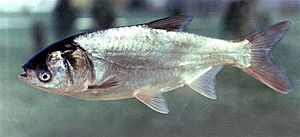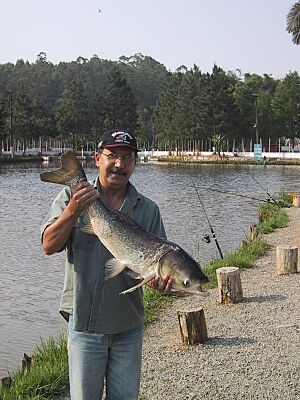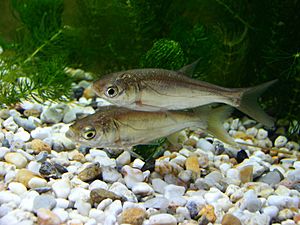Silver carp facts for kids
Quick facts for kids Silver carp |
|
|---|---|
 |
|
| Conservation status | |
| Scientific classification | |
| Synonyms | |
|
The silver carp (Hypophthalmichthys molitrix) is a type of freshwater fish. It belongs to the carp family. This fish is originally from China and eastern Siberia. It lives in rivers like the Amur River in the north and the Xi Jiang River in the south.
Even though it is a threatened species in its natural home, people in China have been raising silver carp for a long time. In fact, more silver carp are raised in aquaculture (fish farms) around the world than almost any other fish. They are often farmed with other Asian carp species.
Silver carp have also been brought to at least 88 other countries. They were usually brought in for fish farming. Sometimes, they were used to help wild fish populations or to keep water quality clean. In some places, these fish are now seen as an invasive species.
A typical silver carp grows to be about 60 to 100 centimeters (24 to 39 inches) long. Some can grow up to 140 centimeters (55 inches) and weigh as much as 50 kilograms (110 pounds).
Contents
What Silver Carp Eat
The silver carp is a filter feeder. This means it eats by filtering tiny bits of food from the water. It has special gill rakers that work like a sponge. These gills can filter out particles as small as 4 micrometers. That's super tiny! A special organ in its mouth helps trap these small particles with mucus.
Silver carp do not have stomachs. They are thought to eat almost all the time. They mostly eat phytoplankton, which are tiny water plants. They also eat zooplankton (tiny water animals) and detritus (dead bits of plants and animals).
In places where silver carp have been introduced, they can compete with native fish. These native fish also eat plankton. Examples in North America include paddlefish and gizzard shad. Young fish of almost all species also eat plankton.
Because they eat plankton, silver carp are sometimes used to help control water quality. They can help control harmful blue-green algae. However, some types of blue-green algae, like Microcystis, can pass through the carp's gut without harm. They can even pick up nutrients and grow more. This means silver carp can sometimes make blue-green algae blooms worse. Microcystis can also produce more toxins when silver carp are around. These carp have natural defenses to the toxins. But they can sometimes have enough toxins in their bodies to be unsafe for people to eat.
Life Cycle and Conservation
In their natural homes, silver carp swim upstream to lay their eggs. The eggs and larvae then float downstream. Young fish hatch in areas that flood. When they are very young, they eat zooplankton. As they grow, they switch to eating phytoplankton. Silver carp are a bit sensitive to low oxygen levels in the water.
The silver carp is currently listed as near threatened in its original range. This means its population is decreasing. This is due to things like dams, pollution, and overfishing. The number of silver carp has dropped a lot in China.
Fishing for Silver Carp
Silver carp are filter feeders, so they are hard to catch with a regular fishing hook and line. Special ways have been created to catch them. One popular method is the "suspension method." This uses a large ball of dough that slowly breaks apart. Tiny hooks are hidden inside the bait. The whole setup floats under a large bobber. The fish eat the small pieces from the dough ball. They bump against the ball to get more food. Eventually, they get caught on the tiny hooks.
In some places, people use "snagging gear." This involves large, weighted treble hooks that are pulled through the water to hook the fish. In the United States, silver carp are also popular for bowfishing. People shoot them with bows and arrows both in the water and in the air. To make them jump, people use powerboats to scare the fish. They shoot the fish when they leap out of the water.
Other Carp Species
There are two other species in the same group as the silver carp. These are the bighead carp (H. nobilis) and the largescale silver carp (H. harmandi). The bighead carp acts differently from the silver carp. It does not jump out of the water when scared. It also eats different things. Bighead carp are also filter feeders. But they filter larger particles and eat more zooplankton. Silver carp eat more phytoplankton. In some parts of the United States, bighead and silver carp can breed together. Their young can also have babies.
The largescale silver carp is very similar to the silver carp. Its natural home is south of where the silver carp lives, mostly in Vietnam. Unlike bighead and silver carp, largescale silver carp have not been spread around the world for farming. However, some were brought to the Soviet Union. There, they bred with the introduced silver carp.
Silver Carp in North America
Silver carp were brought to North America in the 1970s. They were used to control algae in fish farms and wastewater treatment plants. But they soon escaped. Now, they are seen as a very invasive species.
Silver carp, along with bighead carp, can grow to very high numbers. They can harm the local environment and native fish. They have spread into many rivers in the United States. These include the Mississippi, Illinois, Ohio, and Missouri rivers. They are common in the Mississippi river system from Louisiana to South Dakota and Illinois.
Dams have slowed their spread up the Mississippi River. Until late 2008, silver carp had not been caught north of central Iowa on the Mississippi. Dams without navigation locks completely stop silver carp from moving upstream. However, fishermen can accidentally help them spread by using them as bait.
In 2020, silver carp were found in Alabama's Pickwick and Wheeler reservoirs. These are on the Tennessee River. But the species has not spread further in Alabama's waterways.
The Tennessee Valley Authority (TVA) is looking at ways to control Asian carp. They are thinking about fish barriers at 10 locks. One idea is a bioacoustics fish fence. This barrier uses sound, light, and air bubbles. These barriers are being tested at Barkley Lock and Dam in Kentucky. They are studying how well they stop Asian carp. Other barriers use carbon dioxide and electricity. The TVA is also studying how these barriers might affect native fish. They are also thinking about changing water flow during carp spawning times. Carp eggs need high water flow to float. If the flow is low, the eggs sink and die.
The silver carp is sometimes called the "flying" carp. This is because it often jumps out of the water when scared. It can jump up to 10 feet (3 meters) high. People in fast boats have been hurt by hitting airborne fish. One silver carp broke a teenager's jaw while they were tubing. Water skiing in areas with silver carp can be very dangerous.
It's strange that this extreme jumping behavior mostly happens with silver carp in North America. Those in Asia and other parts of the world jump much less. Scientists are not sure why this is. Some ideas include the high numbers of fish in North America. Another idea is that the fish brought to North America might have come from a small group of "jumpy" individuals.
Images for kids
See also
 In Spanish: Carpa plateada para niños
In Spanish: Carpa plateada para niños





